Chapter 17.20
FENCES AND WALLS
Sections:
17.20.010 Requirements.
No person shall construct any multifamily or nonresidential fence in the City of Airway Heights without first obtaining a permit from the Building Department. The lack of a permit requirement does not waive the responsibility for all fences in complying with the provisions found within this chapter. A site plan must be submitted showing the property lines, location, length, height and type of fence being installed. A survey may be needed if applicant cannot locate property markers. This chapter does not apply to fences or walls 30 inches or less in height, measured from grade, unless such a wall is structurally supporting additional weight from a building or parking area as required by the International Residential Code.
A. Residential fences, landscape walls and decorative posts may be constructed of wood, stone, brick, wrought iron, chain-link and wire mesh, except wire mesh is not permitted within the street yard or the side street yard. Residential fences shall not exceed three and one-half feet in height when located within the front yard setback, and shall not exceed six feet in any other part of the property.
1. Berms may not be built to increase fence height; fence is measured from the existing ground level as measured from the outside of the property line. A two-inch gap may be permitted below the fence, which allows the fence to measure at six feet, two inches.
2. Replacement of fences with prior permits is permitted; new fences and fences without a permit require a building permit application.
3. A variance of the fence height regulations may be granted if, after investigation by the planning department, it is found that site or terrain or nuisance animal conditions warrant a waiver of height restrictions.
4. Barbed wire may not be used in fencing for any residential use, including those found within the commercial (C) and industrial (I) zones.
5. Fence height measurements:
a. For chain-link fences, the fence line height is measured from the top of the fence post to the existing grade.
17.20 Figure 1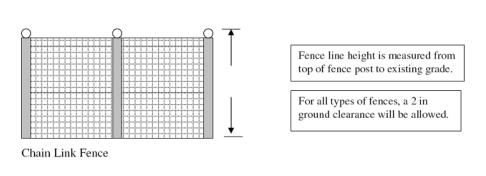
b. For picket fences, the fence line height is measured from the top of the fence pickets to existing grade.
17.20 Figure 2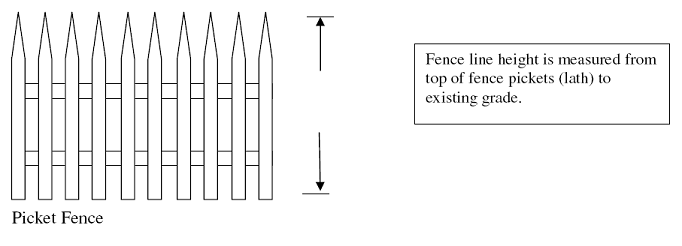
c. For privacy fences, the fence line height is measured from the top of the fence pickets to existing grade, irrelevant of whether the fence has decorative caps, as long as they are no higher than four inches.
17.20 Figure 3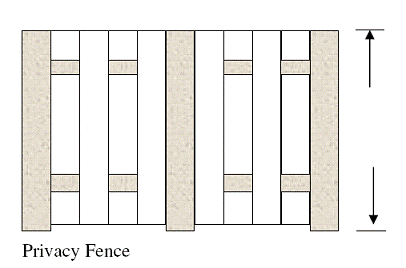
d. Fence line height is measured from the top of the horizontal fence line of the exterior face to the existing grade. The horizontal fence line is defined as the horizontal line from top of fence post to fence post. If the topography at grade is sloped in parallel, the fence shall be installed in a stepped fashion or sloped with the grade; see Figure 4. A maximum four-inch variance is allowed from grade to bottom of each fence lath when topography is inherently uneven. However, the fence line height shall not exceed six feet.
17.20 Figure 4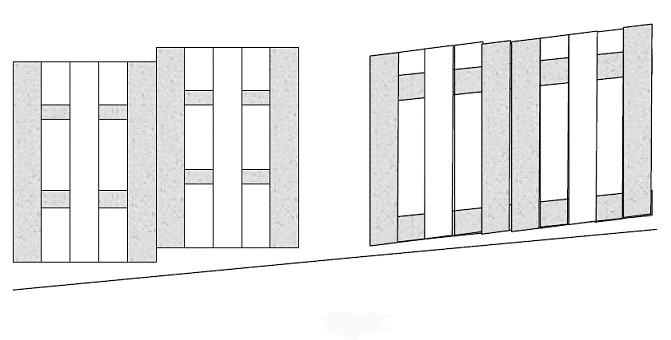
e. Fences built on retaining walls shall be measured from the existing elevation, prior to construction of a retaining wall, to the top of the fence.
17.20 Figure 5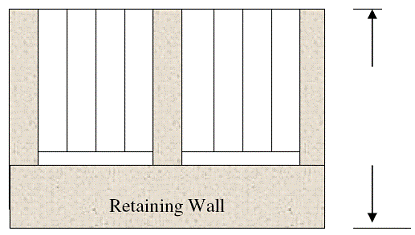
B. Fences for nonconforming residential uses in the commercial (C) and industrial (I) zones shall comply with the fence requirements of subsection (A) of this section.
C. Fences, walls and decorative posts in industrial (I) zones may be constructed of wood, stone, brick, wrought iron, chain-link and wire mesh. They shall not exceed six feet when located in any other of the required setback areas, except as provided for electrical fences under subsection (H)(1)(b)(viii) of this section or barbed wire fences under subsection (I)(1) of this section.
D. Fences, walls and decorative posts in commercial (C) zones may be constructed of wood, stone, brick, wrought iron, chain-link and wire mesh. They shall not exceed three and one-half feet in height when located within a required front setback, and shall not exceed six feet when located in any other part of the setback area.
E. Fences, walls and decorative posts in public (P), recreation (R), or open space (OS) zones may be constructed of wood, stone, brick, wrought iron, chain-link and wire mesh. They shall not exceed three and one-half feet in height when located within a required front setback, and shall not exceed six feet when located in any other part of the setback area. All outdoor trash or refuse containers serving offices, community infrastructure, or other nonresidential uses shall be screened on all sides from public view by a minimum five-and-one-half-foot-high wall or fence.
F. Temporary fences are permitted for up to 180 consecutive days or for intervals not exceeding an aggregate of 180 days in any calendar year. A temporary fence does require a fence permit.
G. Front yard hedges, fences, and walls that are continuous in length shall have one access opening a minimum of 36 inches in width and shall remain unobstructed by any items other than a gate in order to form a clear passage to the street. Fences, walls, and hedges which existed before the adoption of the ordinance codified in this section that exceed the prescribed height or access opening requirements and pose a life safety hazard as to ingress and egress shall be required to provide such access points as defined in this chapter.
H. No electrical fences may be maintained in any residential, commercial, open space or recreational zone.
1. Electric fences shall be permitted under the following conditions:
a. Electric fences used for the confinement of animals shall conform to the Washington State Rules and Regulations for Electrical Wiring, Chapter 19.28 RCW, as to voltage, amperage, and safety factors, and shall be energized only with Underwriters Laboratories approved equipment. Electric fences used for the confinement of animals shall be marked with warning signs spaced every 100 feet along the fence.
b. Electrical fences used for any other purpose other than in subsection (H)(1)(a) of this section shall be located only within nonresidential sites within the I-1 light industrial or I-2 heavy industrial zone. Additionally, electrical fences may be considered through a conditional use permit for nonresidential uses identified as conditionally permitted within the C-2, highway corridor zone consistent with Table 17.10.040, Commercial Zoning Districts Allowed Uses, as well as, 17.05 Table 1, Zoning Matrix, and conform to the following:
i. Unless otherwise specified herein, electric fences shall be constructed or installed in conformance with the specifications set forth in International Electro Technical Commission (IEC) Standard No. 60335-2-76.
ii. Electrification.
(A) The energizer for electric fences must be driven by a commercial storage battery not to exceed 12 volts DC. The storage battery must be primarily charged by a solar panel. However, the solar panel may be augmented by a commercial trickle charger.
(B) The electric charge produced by the fence upon contact shall not exceed energizer characteristics set forth in paragraph 22.108 and depicted in Figure 102 of IEC Standard No. 60335-2-76.
iii. No electric fence shall be installed or used unless it is completely surrounded by a nonelectrical fence or wall that is six feet in height.
iv. There shall be a space of four to 12 inches between the electric fence and the perimeter fence or wall.
v. Electric fences shall be subject to the screening requirements of AHMC 17.22.070 when installed adjacent to, across a street or alley from a nonindustrial zone.
vi. Electric fences shall not be installed within 150 feet of a property line for a residence, or from a school, or day care facility, unless the exterior perimeter nonelectrified fence is covered with a solid covering (e.g., solid mesh, slats, etc.) to further prevent contact with the electric fence.
vii. Electric fences shall not be installed within five feet of a sidewalk, trail or other pedestrian connection unless the exterior perimeter nonelectrified fence is covered with a solid covering.
viii. Electric fences shall have a maximum height of 10 feet and a minimum height of six feet.
ix. Electric fences shall be clearly identified using a warning sign sized no less than nine inches by 12 inches that reads: “Warning – Electric Fence” at intervals of not less than 60 feet.
x. Electric fences shall be governed and regulated under burglar alarm regulations and permitted as such.
xi. Fire and/or Police Department access must be provided through an approved device that acts as a disconnect such that entry to the premises removes risk of shock occurrence.
(A) In the event that access by the Fire Department and/or Police Department personnel to a property where a permitted electric fence has been installed and is operating, is required due to an emergency or urgent circumstances, and the approved access device referred to in this section is absent or non-functional, and an owner, manager, employee, custodian or any other person with control over the property is not present to disable the electric fence, the fire or police personnel shall be authorized to disable the electric fence in order to gain access to the property.
(B) As a condition of permit issuance, all applicants issued permits to install or use an electric fence as provided in this section shall agree in writing to waive any and all claims for damages to the electric fence against the City of Airway Heights and/or its personnel under such circumstances.
xii. A certificate of insurance indemnifying the City of Airway Heights shall be submitted with the application for electric fencing subject to approval from the City Attorney.
xiii. It shall be unlawful for any person to install, maintain or operate an electric fence in violation of this section.
I. Barbed wire shall be permitted within industrial (I) zones. Barbed wire shall not be permitted on any properties with a residential use.
1. If permitted per this subsection (I), barbed wire, not exceeding three strands, may be permitted at the top of a fence; providing, that the arms do not project over public property. The minimum height to the bottom strand of the barbed wire shall not be less than six feet from finished grade and eight feet to the top of the barbed wire.
2. In all cases where a barbed wire fence is requested, an application shall be made to the Building Official.
3. A certificate of insurance indemnifying the City of Airway Heights shall be submitted with the application for barbed wire fencing subject to approval from the City Attorney.
J. Swimming pools, both public and private, shall be surrounded by a six-foot-high fence, with a gate having latching hardware operable only from the pool side of the fence.
K. Notwithstanding any provision of the currently adopted International Residential Code, a permit must be obtained from the City before any fence is constructed. The fee for such permit shall be in accordance with fees specified in the currently adopted International Residential Code fee schedule or as revised by the City.
L. All fences shall be maintained in a structurally sound manner. (Ord. C-986 § 1, 2022; Ord. C-675 § 255, 2008)


